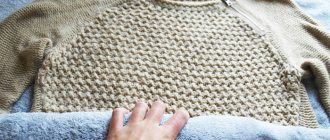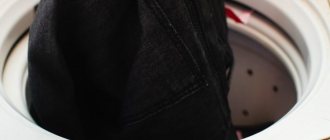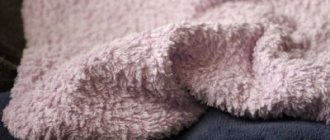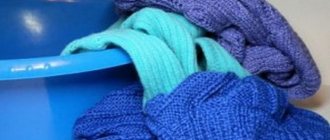Why does a thing lose its shape?
The main reasons for things to stretch after washing include improper washing and subsequent drying. Additional reasons not related to the washing machine are wearing the item for too long and bad habits of the person himself. Many people like to stretch the sleeves, pull the bottom tightly over the hips, and roll up the neck - this is done primarily to feel more comfortable and warm. But when performing such manipulations with a thing, it is important to remember that it will not pass without a trace - stretching will appear on certain parts of the product.
The speed at which a thing stretches and loses its shape also depends on the density of the loops. For example, if it was created by machine knitting, it is characterized by high density and resistance to stretching. If we talk about warm hand-knitted sweaters, then we should note the weak density of the loops. Moreover, there is no way to avoid such density. Each hand-knitted product loses its shape much faster than other things.
Sellers of knitted items advise that before washing, drying and wearing the product, do not neglect the information from the manufacturers, which is indicated on the label or packaging. You can also find such information on the official website. How to reduce a stretched sweater after washing? To do this, there are universal and effective ways to restore things.
Is it possible to return to the previous form?
Unfortunately, not all mechanically damaged tissue can be repaired. There are certain materials that cannot be restored at all or only in certain cases:
- acrylic, cotton material and things with a synthetic base do not restore their shape in any way;
- You can try to restore cashmere, wool and mixed fibers with a large amount of wool.
How to wear a cowl-neck sweater?
What to wear with a cowl-neck sweater? With relatives’ jeans (“mom’s” jeans, “your boyfriend’s” jeans), tucking a cowl-neck sweater inside the jeans. Such a set is loyal to various shoe additions: sneakers with sneakers, high-heeled shoes. With classic trousers, cropped trousers, culottes.
Interesting materials:
How far in advance do you need to arrive at the airport? How far in advance do you need to arrive at the airport? How long does it take to check in for a plane? How far in advance should I arrive at the international airport? How far in advance should I arrive at the airport for the domestic flight? How long does it take to check in for an Aeroflot flight? How long does it take for testosterone to recover? How long does it take to board for domestic flights? I forgot SNILS, how can I find out? Why do you need a bar?
Restoring the shape of a thing
If a wool sweater stretches after washing, what should you do? You can restore the shape of a thing and its size using several methods at once.
If, after washing, a machine-knitted sweater has lost its original structure, then to restore it, you just need to put the product in the washing machine again, following the following rules:
- before throwing the item into the drum, you need to place it in a special bag;
- pour wool detergent into the compartment with the powder;
- activate quick wash mode;
- set the minimum temperature - only 30 degrees is enough;
- Before starting, be sure to turn off the spin mode - use the simple drain function;
- disable automatic drying of items;
- At the end of washing, the sweater is removed from the bag and gently wrung out by hand.
Soda and wine vinegar
One of the most effective ways. Dilute 50 g in 5 liters of cool water. soda Soak the wool in the resulting solution for at least 12 hours. After the expiration date, lightly wring out the wool and transfer it to another solution.
For it, dissolve 10 tbsp. spoons of wine vinegar in 2 liters of water. Immerse clothes in the composition for 2 hours. Periodically, it is necessary to turn the fabric over so that it is evenly covered with liquid.
The next step is rinsing and hand stretch drying.
Improved shape after repeated washing
My sweater has stretched out after washing - what should I do? When reconstructing a product, you need to perform the following steps:
- The sweater is carefully laid out on a towel or piece of fabric.
- Next, the owner gives the item the look that he considers ideal - the fabric in the sleeve area is pulled up, the waist is tightened and the neckline is neatly folded. To do this, you need to place your palms on the things and carefully, gradually grabbing the material, move them towards each other, avoiding the formation of folds. Smoothing the item begins with the seam, then gradually moves to the neckline and sleeves, then touches the remaining areas of the fabric.
- You can see the result immediately after the item is completely dry. The sweater will not lose the shape that the owner tried to give it at the time of reconstruction. It is important not to miss anything when recreating the volume of a thing anew.
Some sweater owners try to reduce it by several sizes by washing it. To do this, experts advise simply washing things in a machine at high temperature.
When drying, it is important to pay special attention to the condition of the towel mat. Immediately after it gets wet, it is important to remove it and place a new one under the item. When re-folding, the sweater must be re-shaped into the desired shape. If you do not change wet towels, the sweater may develop an unpleasant odor due to dampness.
What is the difference between wool and synthetic sweaters?
The sweaters we wear can be made from wool, synthetic or acrylic threads. Wool is a natural raw material, and synthetics and acrylic are artificial substitutes. Each material has its own advantages and disadvantages:
- Heat resistance. Wool is considered breathable and warmer.
- Elasticity. Synthetics have a stronger stretch and quickly return to their original position. Due to this property, the fabric fits better on the figure.
- Durability. Natural material will last longer than artificial material.
- Convenience. As a rule, acrylic is more pleasant to the body, so it is more comfortable to be in such clothes.
- Appearance. But here everything is individual, since people have different tastes. Products made from both materials can look attractive.
Sweatshirts consisting of a combination of natural and artificial raw materials are becoming increasingly common.
Improving your shape with your own hands
What to do if the sweater has stretched after washing? This problem can be solved by another method - to act manually. To do this you need to do the following:
- The bath is filled with a small amount of warm water.
- The stretched item is carefully laid out on the surface of the water. In this case, you need to wait a little so that the sweater has time to soak in the liquid.
- After getting wet, the water goes down.
- The thing is doing push-ups.
- The sweater is wrapped in a terry towel and wrung out again. All actions must be careful; twisting is prohibited.
- The wet item is laid out on a towel in the same way as in the first case. The main thing is to give the sweater the most correct shape possible instead of being stretched out.
- If all steps were performed correctly, then when it dries, the sweater will restore its shape and previous size.
Some dry things differently - directly on themselves. Of course, you can restore an item by wearing it on your body, but the owner is unlikely to feel good. It is best to restore an item using this method if there is a mannequin nearby with approximately the same parameters, which will help reproduce the shape of the figure and return it to its previous shape.
It is important to remember that when using this method, the item can continue to dry throughout the day, and sometimes longer - this directly depends on the density of the material. It is forbidden to try to speed up the drying process by moving the product onto a radiator, heated towel rail or heating device - this will ruin the thing (you will have to throw it away).
Alcohol and turpentine
In 5 liters of water you need to dissolve 3 tbsp. spoons of ammonia and 1 tbsp. spoon of medical alcohol and turpentine. Stir and place the damaged item into the solution. Leave to soak for 1-1.5 hours. Remove clothing from the liquid and rinse in clean water at the same temperature as used for soaking.
After rinsing, the wool is wrung out a little and placed on a hard horizontal surface, covered with a terry towel. Periodically, the towel needs to be changed, and the clothes should be slightly stretched with your hands.
Partial restoration
If after washing, drying or wearing only a certain area of the sweater has lost its shape, then you can use the following method:
- wet the damaged fabric of the item with a water spray;
- carefully lay the sweater on a towel or terry cloth;
- give the lost area its previous shape;
- After a few hours, the sweater will acquire a uniform structure and a suitable size.
A hairdryer will help speed up the drying process. But only cold air flow is allowed for this. Hot jets can only damage the fabric and make it unusable.
Reducing individual elements
If the elastic band on a sweater has stretched, i.e. not the entire product, but its separate part (sleeves, neckline), then it can be restored separately without subjecting the entire fabric to water procedures. The jacket should be laid out on a flat horizontal surface. Use a spray bottle to moisten problem areas. When the fabric gets wet, it should be pulled so that the threads move in the opposite direction from the stretch. You can secure this position with a pin or rubber band. The sweater is left in this position until completely dry.
If the cuffs or other parts of the product have not stretched much, after moving the threads to the center, you can speed up the process of removing excess moisture. You can dry the sweater using an iron. To avoid damaging the fabric, it is recommended to iron the product through a piece of gauze folded several times. You can use a terry towel, but with each new ironing you should cover the jacket with the dry side.
Another method that cannot always be used to make a sweater smaller; in most cases, it is suitable for those products that were independently knitted. You can unravel the stretched part and then bandage it. To avoid having to unravel the entire sleeve if only the cuff is stretched, it is recommended to give preference to a needlework style that involves knitting from the elbow to the hand. There are fewer problems with the neck. In most cases, it is knitted separately from the body of the sweater and then sewn on.
Additional Methods
My sweater has stretched out after washing - what should I do? If the previous methods did not correct the situation, then the following measures are used:
- If the item has stretched slightly as a result of long wear, it will be easy to return it to its previous shape by washing it in cold water and drying it in a horizontal position.
- The sweater is soaked in hot water for 10–15 minutes, and a special detergent for washing woolen items is added. After soaking, hand wash. Next, leave the item in cold water for 20 minutes, having previously wrung out the fabric without unscrewing it. The sweater is dried on a horizontal rack. After all the excess water has drained away, the item is carefully laid out on a dry towel, sheet or any other fabric. Afterwards it is given the desired shape.
So that this doesn't happen again
Naturally, it is best and easiest if you no longer have to deal with this problem. To do this, you need to follow a few simple recommendations:
Ironing should be done very carefully!
- Knitted items are washed only by hand and only in warm water.
- Washing in hot water leads not only to deformation of wool fibers, but also to their fading - high temperatures contribute to the rapid washing out of the dye.
- Do not add excessive amounts of detergent.
- Try to use liquid products rather than powders. The latter are more difficult to wash out of wool fibers.
- Do not twist the product while spinning! This will further lengthen and deform the fibers.
- Try to only use detergent that is designed for the material the sweater is made from.
- Do not dry knitted items in a dryer, on hangers, or in any other hanging position! It is because of this that it stretches under its own weight.
The greater the distance between the loops, the more likely there will be stretching.
- The only optimal drying option is in a horizontal position, on a towel or other material.
- Do not dry wool on a radiator, in the sun or near other heat sources. This causes the fibers to coarse and become stiff, making wearing such a sweater uncomfortable.
- You can iron a woolen product only at the lowest temperature and only on the reverse side.
- Store the product rolled up in a closet. If it hangs on hangers, this can also cause stretching.
You now know what to do if your sweater stretches after washing. However, try to prevent this from happening - use our care tips.











